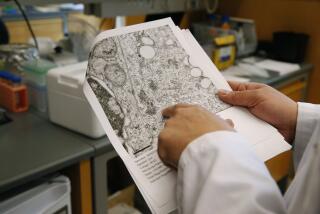Giardia Cases Seem on Rise in Camarillo : Medicine: Officials say more and more people in the city are getting sick from the intestinal parasite. They have yet to figure out how it is being spread.
Camarillo residents are contracting the painful intestinal parasite giardia in increasing numbers, puzzling health officials who have been unable to track down the source of the infection.
Last year, 117 cases were recorded in Camarillo, accounting for the largest portion of the county’s 215 documented cases.
This year, 35 cases of the disease, which is spread by improper hand-washing or through contaminated water or unwashed food, have been documented in the city of 52,000. Those cases account for half of all the cases in the county in 1991.
And the problem appears to be getting worse.
“It still looks like we’re on the upside of this problem,” said Janice Holden, the infections control coordinator at Pleasant Valley Hospital. “It’s not going down yet.”
The county Department of Public Health Services is re-interviewing those who have been infected to try to isolate how the parasite is being spread. Several months ago, the county conducted a similar survey. Those results were inconclusive.
“It’s frustrating,” said Marilyn Billimek, program coordinator of the Department of Public Health Services. “We just don’t have the answers.”
Symptoms of giardia infection include violent attacks of diarrhea, gas, abdominal pain and nausea. Although it will usually clear up without treatment, drugs can relieve the symptoms and prevent the spread of infection.
“It’s not a life-threatening illness,” said Dr. Lawrence E. Dodds, the medical director for Public Health Services. “But it can be unpleasant.”
The disease’s proper name is giardiasis--giardia being the name of the parasite that causes it. Travelers often bring it back from the tropics, but it is increasingly common in developed countries, according to the American Medical Assn.’s Encyclopedia of Medicine. Hikers sometimes contract the malady after drinking water from contaminated backcountry streams.
The parasite is carried in the stool and often turns up in day-care centers and mental institutions where toilet training may be lacking.
About twice the size of a red blood cell and shaped like a stingray with eight tails called flagella, giardia lurks in the digestive tract. It holds onto the intestinal lining with a suction-cup-like apparatus.
At any one time, 1% to 3% of the people in Southern California--or any urban area--probably carry the organism in their bodies, but may not have the symptoms of the illness, health officials say.
In 1986, officials for the U.S. Environmental Protection Agency reported that the disease was occurring more in urban areas. The agency attributed the increase to aging water systems, outdated water treatment plants and pollutants in the drinking water of metropolitan areas.
Dodds said surface and drinking water has been tested in Camarillo, and the bacteria has not been found.
“We’re just not certain where it’s coming from,” Dodds said. “It’s perplexing.”
So far, he added, no common thread has been found among the people who have become ill in Camarillo. Also, the cases are scattered throughout the city.
In their interviews, health officials are asking specific questions, such as how often victims have come in contact with children, who are prone to the parasite because of their hygiene.
Holden said Camarillo officials noticed the increase at the beginning of last year shortly after Pleasant Valley Hospital started using a new testing system--the only one of its kind in Ventura County.
At first hospital officials thought that the increase was due to the new test. But Holden was suspicious.
Hospital staff checked with other hospitals in the state using the same test and found that the number of positive cases at Pleasant Valley Hospital was much higher.
“We think it’s a big problem,” Holden said. “Thirty percent of the people who are coming in are testing positive. I’ve been beating my head against a brick wall about this.”
Several months ago, Camarillo Councilman Mike Morgan asked the city staff to look into the issue after everyone in his family came down with the illness.
“There were other families that had it too,” Morgan said. “One lady thought she had (colon) cancer.”
But city staff members said they are as befuddled as county and local health officials.
“If it were in the water, then thousands would have it instead of just a hundred,” said John Elwell, the city’s director of community services.
Paul Sanchez, a Camarillo doctor, said he is constantly treating giardia cases. His office has had more cases in the last year than ever before.
“I don’t know if it’s because we’re getting more referrals,” Sanchez said. “But we’re seeing a lot more patients who are testing positive.”
Number of Documented Cases of Giardia in 1990: Fillmore: 3 Moorpark: 9 Oak View: 1 Ojai: 5 Oxnard: 19 Port Hueneme and Pt. Mugu: 5 Santa Paula: 8 Simi Valley: 11 Thousand Oaks: 18 Camarillo: 117 Ventura: 19 Total: 215 Source: Pleasant Valley Hospital
More to Read
Sign up for Essential California
The most important California stories and recommendations in your inbox every morning.
You may occasionally receive promotional content from the Los Angeles Times.










